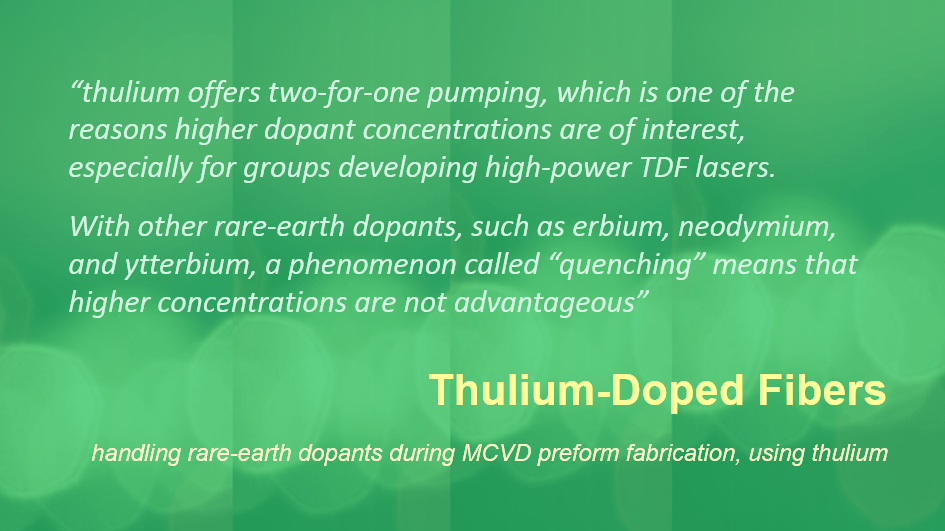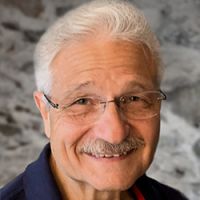This new series of articles from FOC will focus on the production of rare earth doped fiber. The first article in this series, Rare Earth Doped Fibers, discussed the evolution of the main processes for making doped fiber preforms. This article discusses factors in handling rare-earth dopants during MCVD preform fabrication, using thulium as an example. Higher thulium concentrations are of interest for several applications. The MCVD process is well suited for thulium doping but there are challenges associated with use of rare-earth-halide chemicals, minimizing water content, and optimizing the “recipe” for thulium and co-dopants. Subsequent articles in this series will examine other fiber types and preform-production factors in greater detail.
Improved fiber designs and fabrication processes
After 60 years of R&D, doped fiber manufacturers have improved fiber designs and fabrication processes to address factors such as gain-media stability, lifetime, optimum host glass materials, control of dopant concentrations, use of co-dopants, core diameter, core numerical aperture, index profiles, and cladding geometries for optimal pump-power coupling. With decades of progress, doped fibers now support a wide range of commercial lasers and optical amplifiers.
R&D on thulium-doped fibers (TDFs) dates back to the 1980s. Thulium, like other rare-earth dopants, has multiple transition lines. This means the dopants have absorption and emission bands at several wavelengths. Laboratories and companies developing doped fibers often have reasons to investigate those transitions or wavelengths offering the greatest gain in terms of output power per quantity of dopant, per volume of doped fiber, or per unit of pump (input) power. Work on thulium has focused on the gain characteristics of transitions falling in a wavelength region of 1.47 to 2.10 µm.
Other early R&D on rare-earth dopants focused on erbium’s gain region of 1.51 to 1.62 µm, neodymium’s gain region of 0.92 to 1.10 µm, ytterbium’s gain region of 0.98 to 1.14 µm, and holmium’s gain region of 2.04 to 2.17µm. Thulium therefore has attracted considerable interest because it offers a wide region of wavelengths to investigate. Plus, the wavelengths greater than 1.8 µm are especially interesting because they have penetration and power-absorption characteristics that are useful in various materials-processing applications. Over the years, R&D groups also have worked on many fibers with multiple rare-earth dopants or co-dopants to optimize specific pump and gain medium wavelengths
Another interesting characteristic of thulium is that one 790-nm pump photon can produce two excited-state ions. In other words, one pump photon can generate two photons in a TDF laser or amplifier. This “two for one” phenomenon results from the energy-level transitions that promote an ion to an excited state and that transfer energy between ions in thulium. This phenomenon makes thulium attractive for developing lasers with greater efficiency, higher power, and more compact packages.
TDF lasers can be designed for specific wavelengths in the 1.47-to-2.10-µm region by tailoring the host glass material, the pump wavelength, dopant concentration, use of other dopants, and use of laser design elements, such as Bragg gratings, end-face coatings, and other optical components. Wavelengths in this band are well suited for medical diagnostic and therapeutic procedures, lidar, chemical and other sensing, spectroscopy, military counter measures, and material processing applications.
In a silica host, for example, thulium’s longer wavelength band is attractive for surgical procedures. A TDF laser can be tuned to 1.97 µm, which is a water absorption peak. TDF also has advantages over other fiber lasers in terms of eye-safety and the ability to be pumped with widely available 790-nm high-power diode modules. TDF also has been investigated for applications in optical amplifiers, in addition to lasers.

Working toward higher powers
Currently, companies or groups working on doped-fiber laser technology routinely can couple 6 to 10 kW of pump power into a double-clad fiber and get laser outputs in the 3-to-4-kW range. Two key factors in achieving such power levels are 1.) efficiently coupling the pump power into the gain region, and 2.) optimizing the gain medium’s dopant concentration.
Double-cladding configurations are instrumental in the first factor — coupling pump power into the doped core. With preforms fabricated using the MCVD process, the core materials are deposited inside a silica substrate tube. This is true in both the chelate and halide systems. Next, the tube is collapsed into a rod, so the deposited materials become the core and the silica tube material becomes part of the cladding.
The next step would be to put a low-index material on the outside of the silica. In some fibers, this is achieved with a fluorinated silica layer. Use of fluorine, however, limits the numerical aperture (NA) to 0.22. For doped fibers, a high NA is better for coupling as much pump power into the fiber as possible.
An alternative approach is to use a low index acrylate coating as a second cladding. This is put on during the draw process, and it results in fibers with a 0.48 NA. Output powers of 3 to 4 kW are possible with a low-index acrylate coating.
With a subsequent step, the first cladding can be shaped. A cylindrical cladding does not achieve the best coupling of pump power into the core. With a shaped cladding, such as an octagon, the surfaces will mix up the modes to afford better absorption into the core. Using such shaping, an end-pumped system actually is side-pumped, because much of the pump power enters the cladding, bounces around, and enters the core laterally through the core-cladding interface.
The second key factor in achieving higher output powers — higher dopant concentrations — depends on the preform process, but it also requires focus on the starting materials. People want higher concentrations of Tm, but how to achieve that is a big issue.
The two most common vapor-phase processes that use MCVD systems to make rare-earth-doped fibers are the halide process and the chelate process. The chelate process can be used at lower temperatures, say 200o C, but the halide process offers advantages in minimizing OH contamination in the core, which can cause the final glass to have high loss at the wavelength of interest. Further, the halide process offers high conversion efficiency and the potential to achieve higher dopant concentrations. The halide process also can be used with two or more dopants, as can the chelate process.
As noted, thulium offers two-for-one pumping, which is one of the reasons higher dopant concentrations are of interest, especially for groups developing high-power TDF lasers. With other rare-earth dopants, such as erbium, neodymium, and ytterbium, a phenomenon called “quenching” means that higher concentrations are not advantageous. Dopant concentrations of about 1 wt.% of the rare earth ion are used in these cases. With thulium, on the other hand, there is interest in concentrations of 5 wt.% or more. Using the halide process, a preform containing greater than 8.5 wt.% Tm has been fabricated with the subsequent fiber demonstrating record laser slope efficiency.
Achieving such high dopant concentrations requires familiarity with how the chemicals are prepared and transported and how they react. Careful preparation and handling of the rare-earth halides, for example, is a critical factor in dopant concentration and low OH contamination.
Preform fabrication consulting
Rick Tumminelli, co-inventor of double clad fiber laser pumping, partnered with Larry Donalds, preform fabrication expert, work directly with manufacturers of specialty optical preforms and fibers on meeting specific customer applications and performance criteria.
In order to advance their mission to be the industry’s preferred preform fabrication consulting resource, these two respected leaders strengthen the three decade long partnership FOC has had with SG Controls Ltd with a full team of both the extensive process knowledge with engineering and software expertise and the full range of leading equipment and tools for the manufacture of Preforms and Optical Fiber. SG Controls Ltd, combines this extensive process knowledge with engineering and software expertise to produce a full range of tools for the manufacture of Preforms and Optical Fiber.
For more information on key procedures used in making doped fiber preforms with the MCVD, please contact FOC at FiberOpticCenter@focenter.com.



